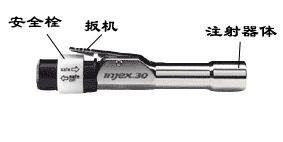The "needleless syringe" market continues to shrink
 Syringes are the most commonly used medical devices in medical institutions. According to reports, the annual sales volume of disposable syringes in the international market is as high as 1.2 billion. However, the traditional syringe must be injected into the skin (or vein) by the needle to inject the liquid. This operation not only causes skin damage to the patient, but also has certain risks (such as accidental breakage of the needle during injection). The developed countries, led by developed countries, began developing needleheads in 1979, and advanced syringes such as the diffusion of drug solution into patients' skins with high-speed airflow.
Syringes are the most commonly used medical devices in medical institutions. According to reports, the annual sales volume of disposable syringes in the international market is as high as 1.2 billion. However, the traditional syringe must be injected into the skin (or vein) by the needle to inject the liquid. This operation not only causes skin damage to the patient, but also has certain risks (such as accidental breakage of the needle during injection). The developed countries, led by developed countries, began developing needleheads in 1979, and advanced syringes such as the diffusion of drug solution into patients' skins with high-speed airflow. Unexpected market response After many years of development, the world's first needle-free syringe product, Medi-Ject, was marketed in the United States in 1992 and approved for insulin injection. According to the manufacturer, the working principle of this product is to use ultrasound and high pressure to atomize the insulin solution to form an ultra-fine particle aerosol. Under high pressure, the insulin aerosol penetrates through the tiny pores on the skin and subcutaneously diffuses. Complete the injection process. Because Medi-Ject did not cause bleeding or other trauma to the patient during use, some famous US international consulting companies such as Frost & Sullivan predicted that new needleless syringe products would set off a storm in the syringe industry. , annual sales are expected to exceed one billion US dollars.
Inspired by the successful launch of new syringes such as Medi-Ject, US manufacturers have successively introduced new needleless syringes such as Vita-Ject and Activa. Some market economic analysts in the United States had boldly speculated that needleless syringe products will gradually replace traditional needle syringe products in the next 10 years. The reason is that needleless syringes have many advantages: 1. Will not cause cross-infection; 2 No pain when injected ( Painlessness of the patient does not cause skin bleeding, etc.; 3 can be used repeatedly.
The price is the biggest weakness. The retail price of needleless syringes is too expensive. This is related to the huge investment invested by the manufacturer in the product development process. According to foreign media reports, Medi-Ject needle-free syringes were sold for as much as more than 1,200 US dollars each when they were put on the market. With the mass production of products and the increase in output, the price dropped to only 798 US dollars each, but in fact it is nothing more than Insulin syringes, where the sale price of each disposable syringe on the international market is only around $0.20 (the cheapest disposable syringe is only a few cents each), compared to needleless syringes as an insulin injection Equipment products are less cost-effective. For people with diabetes, the injection of insulin is a "day-to-day operation" and it must be injected several times a day. Such a high-price needleless syringe will certainly not be the product of choice for most people with diabetes.
Second, at the end of the 1980s, western manufacturers led by NOVO Corporation took the lead in the development of a new type of medical device, the insulin pen, which combines a syringe and a drug solution. To avoid the patient must first refrigerated insulin injection, and then removed from the refrigerator and injection and other troubles. The listing of insulin pens took away the market share of needle-free injectors that had previously been high hopes.
Indications of narrow three are needle-free syringes "congenital deficiency." Its design plan now looks a bit dated. Since then, the new needleless syringes marketed, such as the J-TIP, have been designed as disposable syringes. It also draws on the new concept of “needleless injectionâ€. The high-pressure gas used is very inexpensive carbon dioxide. The syringe also passes through high-speed airflow. Forcing the atomization of the insulin solution into the skin, and the biggest advantage is that the price is low, and the price is only about 2 US dollars each.
In summary, because of the limitations of its own technology, needle-free injectors can only be used to inject small doses of proteins and peptides (such as insulin or other bio-engineering drugs). It is impossible to inject anti-hypertensive drugs with great clinical needs. Pain medications, antibiotics, or anti-cancer drugs have greatly limited their use in hospital clinical practice.
Best Wrist Blood Pressure Monitor ,Wrist Cuff Blood Pressure Monitor,Hylogy Blood Pressure Monitor,Touch Wrist Blood Pressure Monitor
Shenzhen Urion Technology Co., Ltd. , https://www.urionhealth.com
